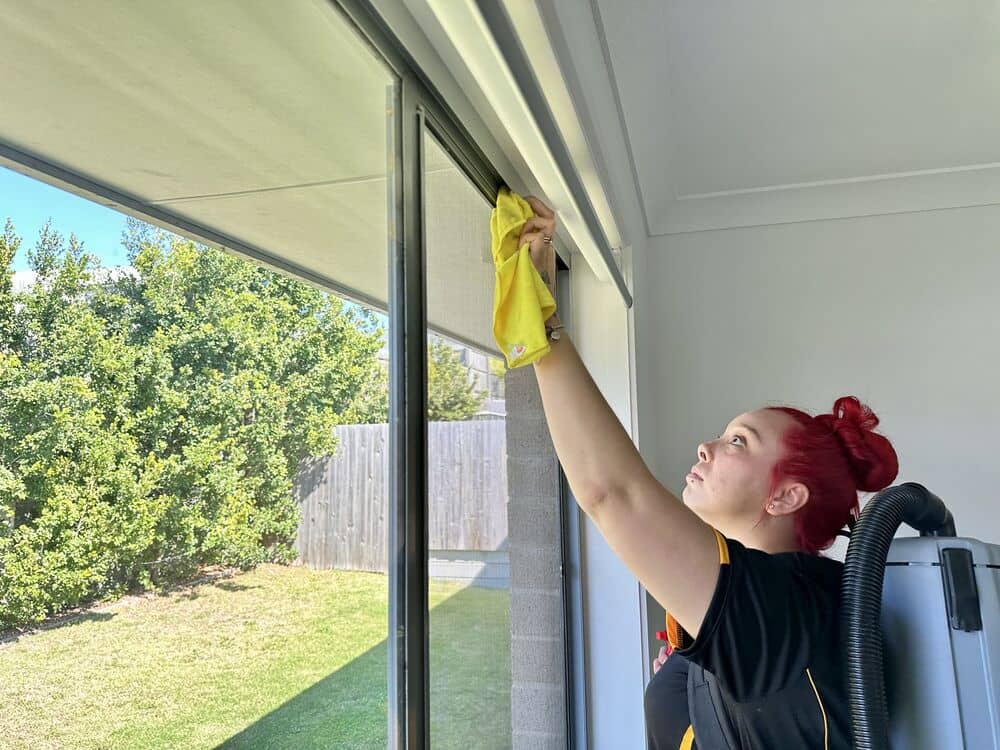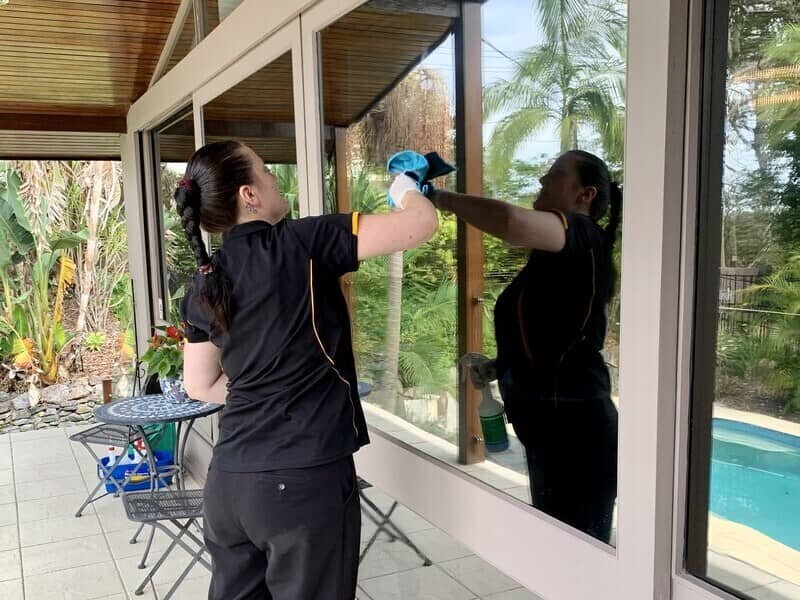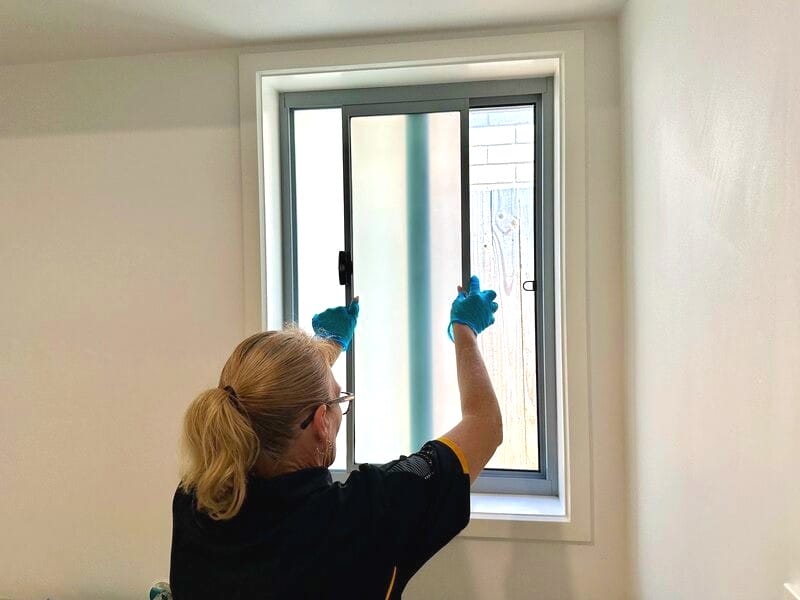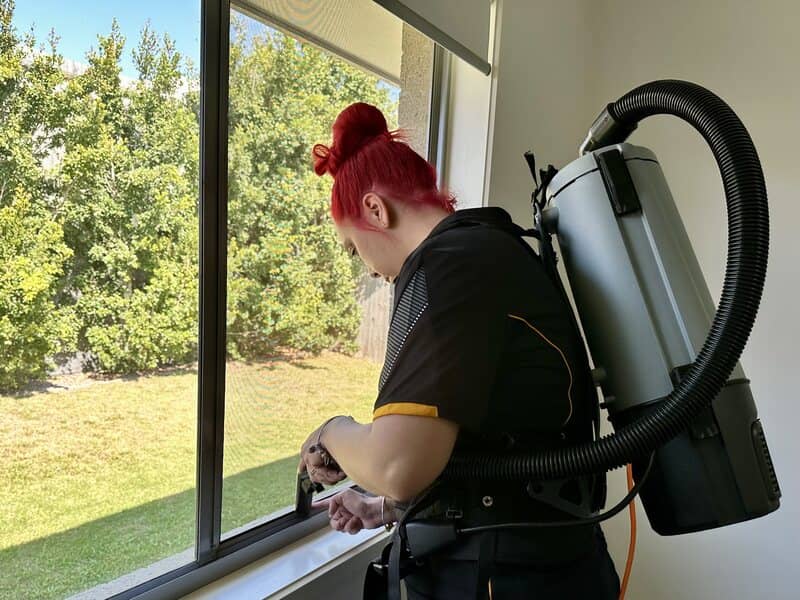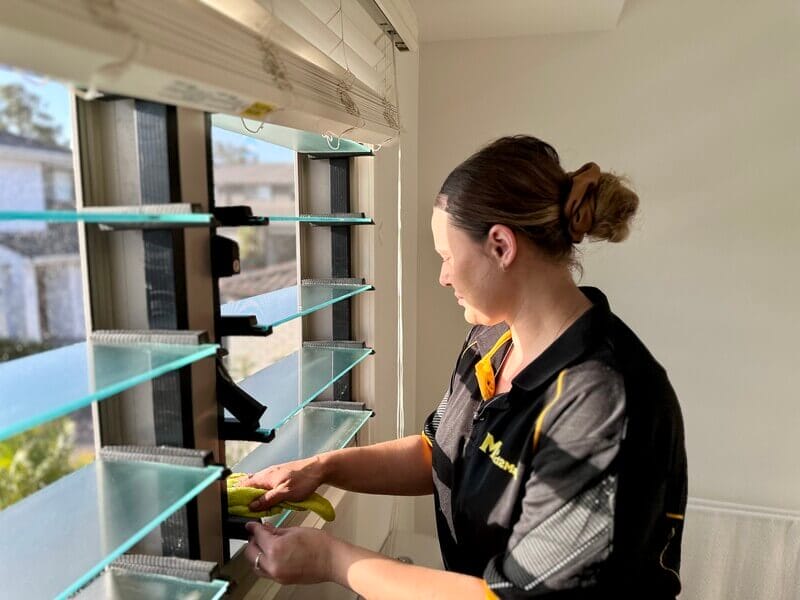It’s delightful to look out the window, bask in the sunshine, and take in the view outside… and then you notice the glass surface is smudged.
Nope, you can’t ignore that! The dust and grime are signs to wash your windows.
We get it, though — tackling all that glass can feel pretty daunting. But the longer you put it off, the more dirt builds up, leading to a streaky or smudged appearance.
Fortunately, you can clean inside windows with soapy water, vinegar, or commercial cleaner! So long as you work quickly, it’s not a complicated chore (though it can be a pain to work on all those panes — get it?).
You don’t need to wash all your windows in one go, but you do need to wash them regularly! Here’s how to get them streak-free and picture-perfect.
What to Use | Tips Before Cleaning | Cleaning Windows Without Streaks | Cleaning Window Frames and Tracks | Cleaning Different Window Types | Unreachable Windows
How Often to Clean Your Windows
Your window cleaning schedule will depend on the weather and environment. If you live somewhere rainy or dusty — or alongside a busy road — you’ll need to clean more frequently.
A good rule of thumb is to clean the inside of your windows every 3–6 months. For the outside surfaces, try to clean them twice a year: spring and autumn.
If you’ve got too many windows and not enough time, add on interior window cleaning when you schedule a flat rate cleaning service with Maid2Match!
What to Use to Clean Windows
You can’t clean windows with just water — using a good cleaning product lets you remove dirt, grime, water spots, and even bacteria or mildew.
Some of the best things to clean windows include:
- Dishwashing liquid
- Distilled white vinegar
- Commercial cleaning products
- Window vacuum
You’ll also need separate cloths, sponges, or squeegees — one for wiping the product, and another for drying or polishing the surfaces.
If you plan to use squeegees, lay some old towels on the window sill or floor to catch any drips!
For people who live in hard water areas, try to use filtered or distilled water to minimise mineral build-up on the glass.
Avoid abrasive cleaners (such as powders) or metal scrapers (like razor blades) since these can permanently scratch the glass.
If necessary, use a silicone, rubber, or plastic scraper (like one for glass cooktops) to remove stubborn dirt or stains. You can also spray 70% rubbing alcohol, then wipe the stain off.
Before You Start: Window Cleaning Tips
To prevent streaks and keep your windows looking good, here are some tips from our home cleaning pros.
1. Get the timing right
It may feel counterintuitive, but don’t clean your windows when it’s sunny outside!
If the sun’s shining directly on the glass, the cleaning solution will dry more quickly — and be more likely to leave streaks or residue.
Work early in the morning or on a cloudy day so you have enough time to wash away the cleaning solution. Use tepid or cold water for rinsing, as this evaporates more slowly.
Moreover, don’t try to clean all your windows at once! Work one room or area at a time, especially if you’re cleaning the outside.
PRO TIP: If you’re also cleaning outside window glass, wipe the inside surfaces horizontally and the outside surfaces vertically.
That way, if you notice any smudging, you’ll know which side of the glass it’s on right away.
2. Use the correct equipment
It’s important to use the right tools so you don’t leave lint or smudges on your windows.
Dusters and vacuums with brush or crevice attachments are great for removing dust.
Microfibre cloths are very absorbent and are great for picking up dust. Meanwhile, non-abrasive sponges can efficiently apply homemade solutions like soapy water.
For drying, a squeegee is best for large windows and won’t leave streaks, but it can be a bit tricky to use.
Don’t forget to wash your tools afterwards. Otherwise, they’ll make your windows dirtier the next time you use them!
NOTE: Newspapers used to be great for polishing glass after cleaning, but not so much these days. The paper may not be as durable and the ink is different — stick to soft cloths instead.
Avoid using paper towels as well, since they can shred or track lint on the glass.
3. Prep before cleaning
Just as you need to vacuum the floor before mopping, you need to dust the windows before cleaning!
Doing this prevents any debris from scuffing the glass and ensures you don’t just push loose dirt around while wiping.
Use a duster or dry cloth to remove dust from the glass surfaces, window frames, handles, and tracks.
You can also opt for a vacuum cleaner with a soft brush attachment, especially for tracks and sills.
How to Clean Windows Streak-Free
Before you start cleaning inside windows, gather all your equipment. Keep everything in one spot (like a caddy) and layer old towels or newspapers if necessary.
Take off any removable fly screens and set them aside to wash later. Then brush the dust and dirt off any frames, handles, and tracks.
Wear gloves to protect your hands and be ready to work fast — you don’t want your cleaning solution to dry!
Using dishwashing liquid
A good anti-grease dish soap can go a long way in your home — and yes, it can clean glass windows, too.
Fill a bucket with warm water, then add a few drops of dish soap. Don’t use too much, as it can leave a residue on the glass if not fully rinsed off.
Dip a soft sponge into the soapy water and wring it out. Using large, zigzag strokes, wipe the entire window from top to bottom.
Rinse the sponge regularly so you don’t spread any dirt around. Then, once the glass is clean, wash off any soap residue with a damp cloth dipped in cold water.
Finally, use a microfibre cloth or squeegee to remove all the excess water. Work from top to bottom and wipe the squeegee blade between strokes.
Spot-dry any remaining damp spots with a clean cloth.
Using white vinegar
Vinegar is particularly good for removing hard water spots and giving you streak-free windows.
Mix equal parts distilled white vinegar and warm water in a spray bottle. Saturate the entire surface of the window, taking care to avoid the frames as much as possible.
(If you have wood or fibreglass frames, apply the cleaning solution with a soft sponge instead.)
Using a microfibre cloth, work the solution over the glass. Use long, zigzagging strokes and work quickly so the mixture doesn’t evaporate.
Afterwards, remove the excess moisture with a squeegee or clean microfibre cloth. For squeegees, wipe the blade between strokes.
NOTE: To clean smeared windows, you can use a more concentrated vinegar spray! The acid helps cut through grime and makes it easier to wipe or scrub off.
Using glass cleaner
Glass cleaner is one of the best ways to clean windows, for obvious reasons!
Some popular window cleaners include Chemical Guys Glass Cleaner or Karcher Window Cleaner Concentrate. For a more eco-friendly option, try Koala Eco’s Peppermint Glass Cleaner.
Follow the product instructions for applying, and be careful not to use too much product! Using too much window cleaner can leave smudges, which can be hard to remove later on.
Use a microfibre cloth to buff the glass afterwards for a streak-free finish.
Using a window vacuum
One of the easiest ways to clean windows is with a window vac, like the Karcher WV 6 Window Vacuum Cleaner.
You get two tools — a spray bottle with a microfibre cleaning pad, and a combination vacuum and squeegee.
The spray bottle applies your cleaning solution, and the attached pad helps you spread it over the window easily. Then the vac removes any moisture, while the squeegee lip leaves a streak-free shine.
Besides windows, the vacuum can clean shower glass, benchtops, and even floors!
Cleaning Window Frames and Tracks
When you deep clean your windows, don’t forget the areas around them, too.
Loosen any dirt in the window frame, tracks, or sill with an old toothbrush or grout brush. Then use a vacuum with a crevice attachment to hoover up all the debris.
Wipe the area with a damp cloth to remove the remaining dirt. If it’s particularly grimey, use a little soap and water, before wiping away the residue with a soft cloth dipped in clean water.
Dry all the surfaces afterwards.
Cleaning Different Types of Windows
It’s pretty straightforward to clean bay, casement, or picture windows — you just need to wipe the large glass panes.
However, some types of windows need a bit more care to maintain.
Awning windows
When cleaning an awning window, don’t forget the seal around the edges. Wipe it with a damp cloth to remove dust or debris, making sure to get between any folds.
Thoroughly dry the seal afterwards.
If you notice mould on the window seals, clean it with hydrogen peroxide! Spray 3% H2O2 onto the seal and scrub off the mould with an old toothbrush.
Wipe off any residue with a damp cloth, then dry the seal.
Louvre windows
A louvre window is perfect for letting in fresh air and natural light even when it’s raining, but it has two downsides — it’s a pain to clean, and it’s a dust magnet.
It can take a lot of time and elbow grease to clean louvre windows, since you need to wipe each “blade” or pane, so work efficiently. Wipe one pane at a time and go from one end to the other, on both sides.
Dry louvres with a clean cloth (especially wooden louvres) to prevent water spots and damage.
NOTE: Louvre windows are different from plantation shutters, which are a window treatment! Plantation shutters are typically made of aluminium, faux wood, wood, or vinyl.
You can clean your plantation shutters in a similar manner, though — dust them with a dry microfibre cloth, then deep clean with a little dish soap and warm water.
Single or double-hung windows
Start by wiping the window tracks and sills with a soft cloth, then lay some old towels on the sill to catch any drips.
Check if the lower sash can be tilted, especially for single-hung windows — it’ll give you easier access.
Pay close attention to movable parts, including locks, handles, and sash balances. Wipe them clean with a damp microfibre cloth and spritz a little WD-40 to lube things up.
Sliding windows
You’ll need to remember to clean the window tracks often — dust and debris build up pretty easily, especially in wet or humid weather.
When cleaning sliding windows, use your vacuum’s crevice attachment to remove loose dirt and debris. After washing the panes, wipe the frames and tracks with a dampened cloth, then follow with a dry cloth.
Make sure to clean all the movable parts, since any gunk buildup can cause the mechanisms to stick (or even break).
How to Clean Unreachable Windows
If you can’t get to a window — say, one that’s very high up — look for a long-handled squeegee or sponge mop. The extendable handles allow you to wipe panes that are out of reach.
Use one squeegee to apply the window cleaner, then another to wipe the surface dry. Be careful when working, and stretch in between so you don’t strain your shoulders!
For outdoor windows, there are “window washers” that you can attach to a hose, like the 30 Seconds Window Wonder or Windex Outdoor Sprayer.
Simply attach the product to your hose and spray the panes. Let the product sit for the recommended time, then rinse off.
Don’t Let Washing Windows Be a Pane
It can be tedious to clean your windows, but your home will look much better for it! Just work one room at a time so you’re not overwhelmed.
Remove the window screens and wash them separately with soapy water. Leave them to dry completely before reattaching them.
Always use a lint-free microfibre cloth while working! Avoid cotton rags or paper towels, which can leave streaks or lint on the surface.
After washing, rinse off any residue with clean water and dry the panes to prevent water spots or streaks.
Now that you know how to clean windows, step back and admire the streak-free glass and the view beyond… until you need to wash everything again, that is!

